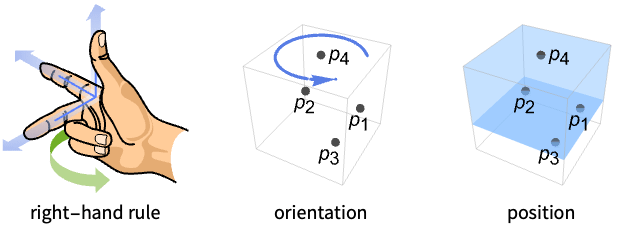PositivelyOrientedPoints[{p1,p2,p3,…,pd+1}]
tests whether the sequence of points p1,p2,p3,…,pd+1 is positively oriented.


PositivelyOrientedPoints
PositivelyOrientedPoints[{p1,p2,p3,…,pd+1}]
tests whether the sequence of points p1,p2,p3,…,pd+1 is positively oriented.
Details

- PositivelyOrientedPoints is also known as counterclockwise or anticlockwise in 2D and right‐hand rule in 3D.
- Typically used to determine the orientation of a rotational motion with respect to a set of points.
- A counterclockwise motion is one that proceeds in the opposite direction to the way in which the hands of a clock move around.
- In two dimensions, the sequence of points p1, p2 and p3 is positively oriented if the orientation of the points is counterclockwise.
- PositivelyOrientedPoints[{p1,p2,p3}] gives True if the point p3 is in the half-plane bounded by the line through p1 and p2 and extended in the direction of {-1,0}.
- For positively oriented points p1, p2 and p3, the determinant of the matrix {p2-p1,p3-p1} is positive.
- In three dimensions, PositivelyOrientedPoints[{p1,p2,p3,p4}] gives True if the point p4 is in the half-space bounded by the plane through the point p1 with normal direction (p2-p1)(p3-p1).
- For positively oriented points p1, p2, p3 and p4, the dot product of p4-p1 and (p2-p1)(p3-p1) is positive.
- In d dimensions, d+1 points p1,p2,…,pd+1 are positively oriented if the determinant of the matrix {p2-p1,…,pd+1-p1} is positive.


Examples
open all close allBasic Examples (2)
Scope (3)
PositivelyOrientedPoints works with two-dimensional points:
PositivelyOrientedPoints works with numerical coordinates:
PositivelyOrientedPoints over a set of coordinates:
Applications (4)
Geometry (2)
PositivelyOrientedPoints over lines in 2D:
It is equivalent to the orientation of the consecutive vertices of the line:
Show the robustness of PositivelyOrientedPoints:
Properties & Relations (4)
PositivelyOrientedPoints returns False for collinear points:
NegativelyOrientedPoints returns False if positively oriented:
Use RegionMember to test whether points are positively oriented:
3D points that are not positively or negatively oriented are coplanar:
Related Guides
History
Text
Wolfram Research (2020), PositivelyOrientedPoints, Wolfram Language function, https://reference.wolfram.com/language/ref/PositivelyOrientedPoints.html.
CMS
Wolfram Language. 2020. "PositivelyOrientedPoints." Wolfram Language & System Documentation Center. Wolfram Research. https://reference.wolfram.com/language/ref/PositivelyOrientedPoints.html.
APA
Wolfram Language. (2020). PositivelyOrientedPoints. Wolfram Language & System Documentation Center. Retrieved from https://reference.wolfram.com/language/ref/PositivelyOrientedPoints.html
BibTeX
@misc{reference.wolfram_2025_positivelyorientedpoints, author="Wolfram Research", title="{PositivelyOrientedPoints}", year="2020", howpublished="\url{https://reference.wolfram.com/language/ref/PositivelyOrientedPoints.html}", note=[Accessed: 07-December-2025]}
BibLaTeX
@online{reference.wolfram_2025_positivelyorientedpoints, organization={Wolfram Research}, title={PositivelyOrientedPoints}, year={2020}, url={https://reference.wolfram.com/language/ref/PositivelyOrientedPoints.html}, note=[Accessed: 07-December-2025]}